Relationship between the plasma nt-Probnp concentration and characteristics of heart failure and premature ventricular complexes in stable ischemic heart disease
Objectives: To investigate the relationship between plasma NT-proBNP levels and
characteristics of heart failure and premature ventricular complexes (PVCs) in patients with
chronic ischemic heart disease.
Subjects and methods: A cross-sectional descriptive study on 136 patients with chronic
heart failure who were diagnosed as stable ischemic heart disease at Military Hospital 103 and
Hanoi Heart Hospital from October 2016 to January 2021. Participants were eligible for
inclusion and exclusion criteria. NT-proBNP was taken at the admission and after treatment.
Medical statistical algorithm was used to determine the correlation between symptoms of heart
failure, PVCs and plasma NT-proBNP.
Results: Patients’ median age was 70.0 ± 10.483. NT-proBNP concentrations pre- and post -
treatment were 2540.846 ± 470.484 and 1162.268 ± 178.840 pg/mL. Patient's age, heart rate,
and creatinine levels were positively correlated with NT-proBNP concentration whereas left
ventricular systolic function (EF%) was inversely correlated with NT-proBNP levels (r = -0.315,
p < 0.001). There was a positive correlation between NT-proBNP concentrations and heart
failure degree according to New York Heart Association (NYHA) (r = 0.406, p < 0.001). The
severity of the post-treatment PVCs significantly decreased, with significant difference (p = 0.027).
But there was no correlation between PVCs and the plasma NT-proBNP concentrations.
Conclusion: Plasma NT-proBNP concentrations are correlated with several features of
heart failure. But there is no correlation between PVCs and plasma NT-proBNP concentrations
in patients with heart failure due to ischemic heart disease
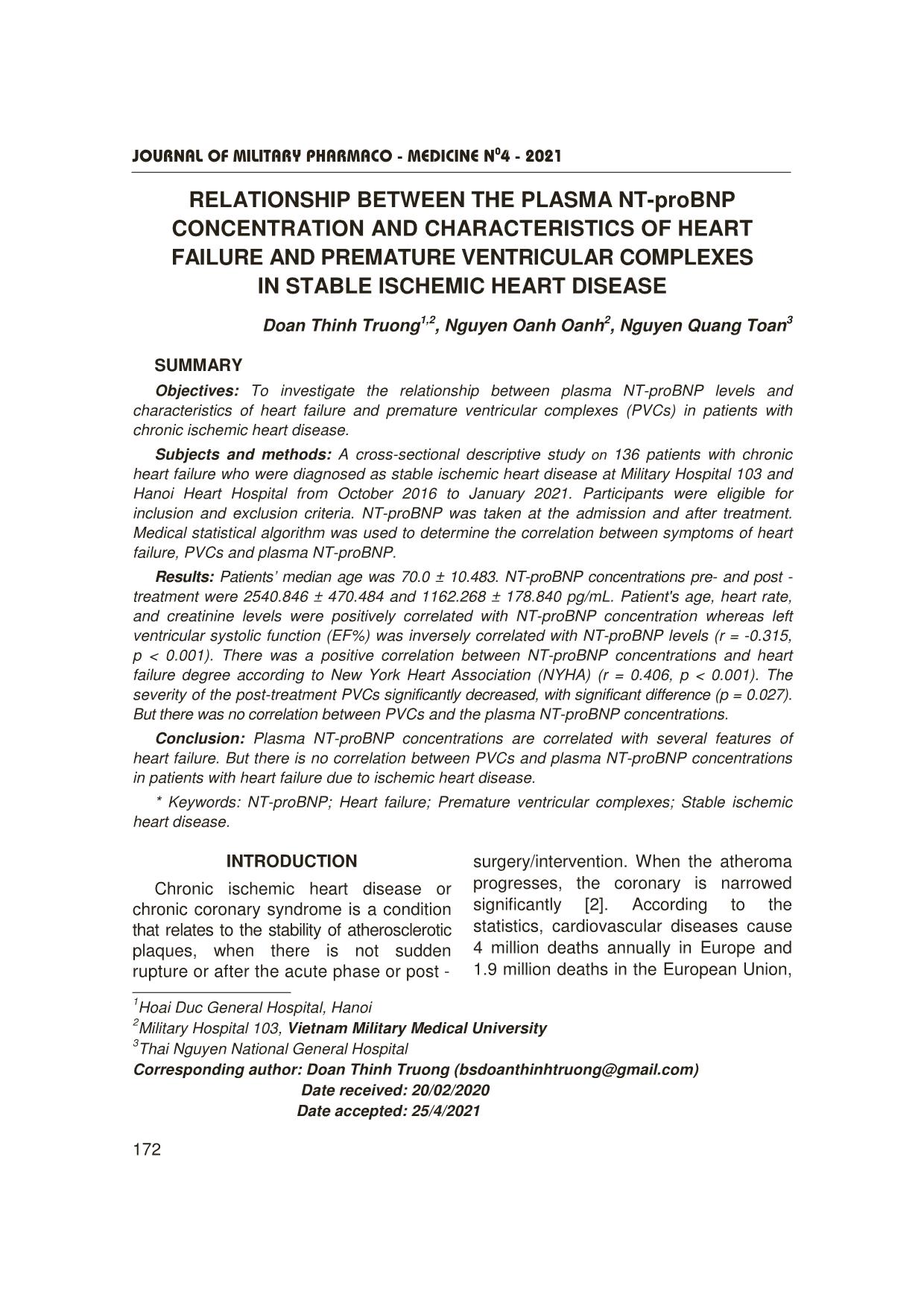
Trang 1
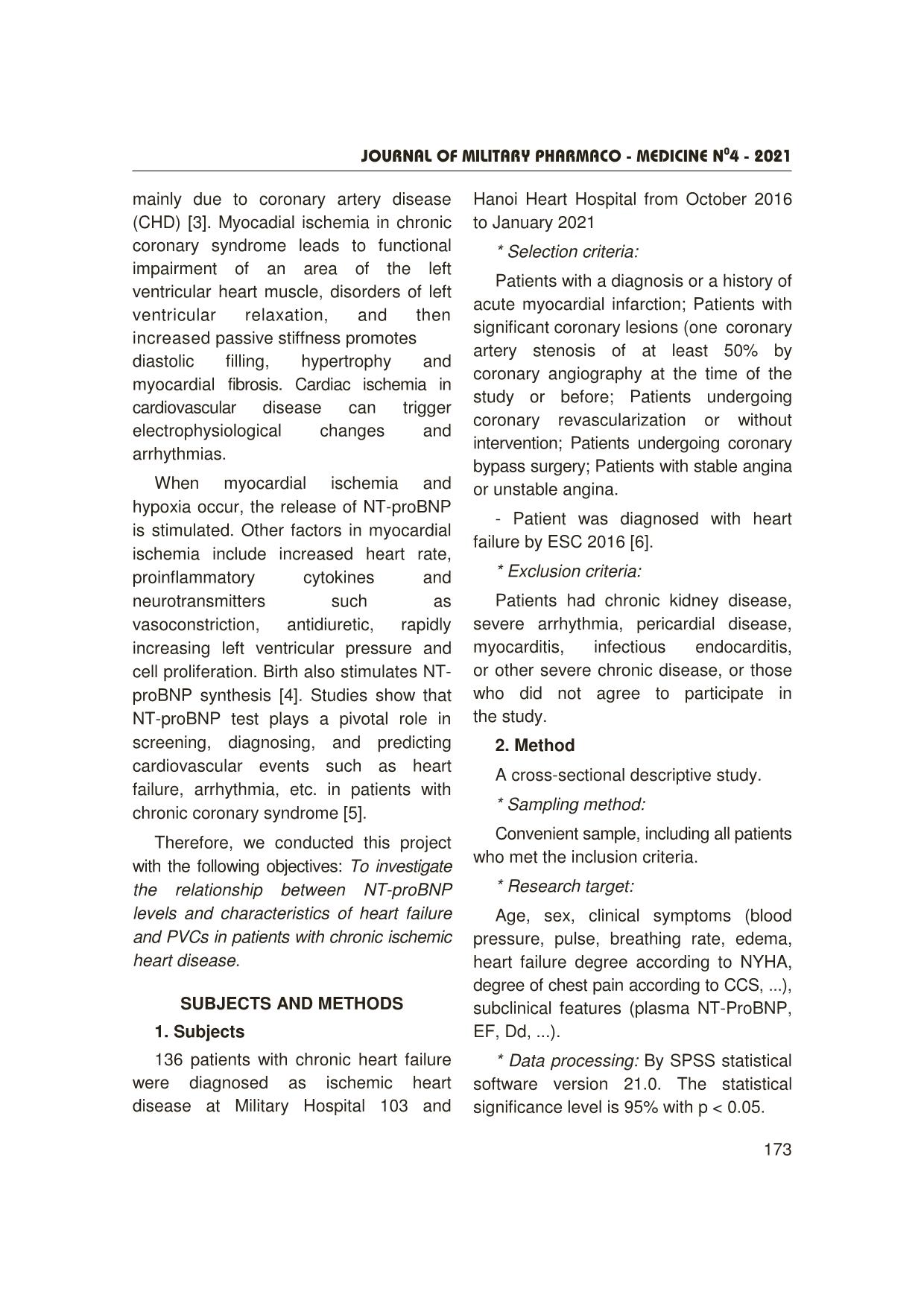
Trang 2
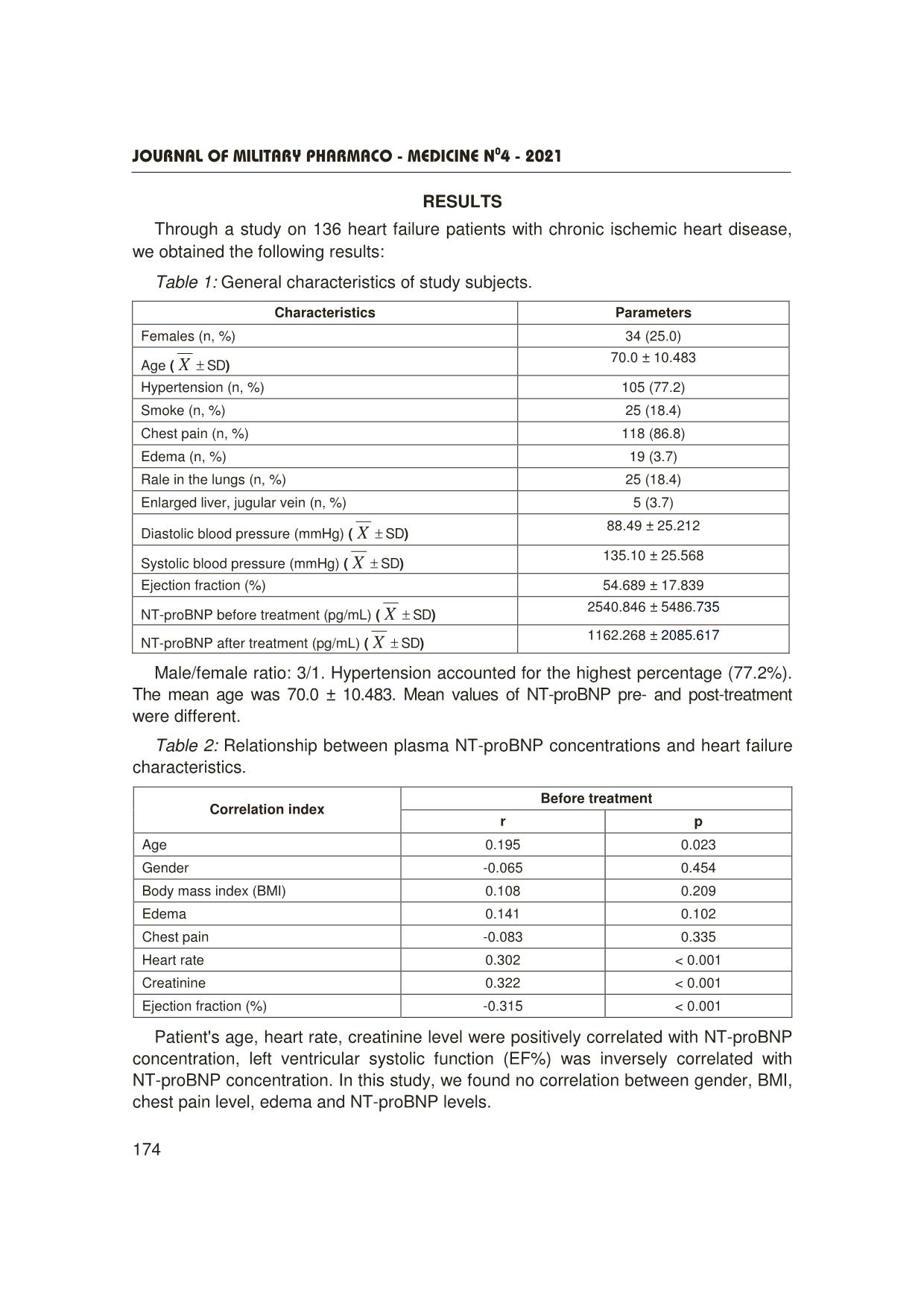
Trang 3
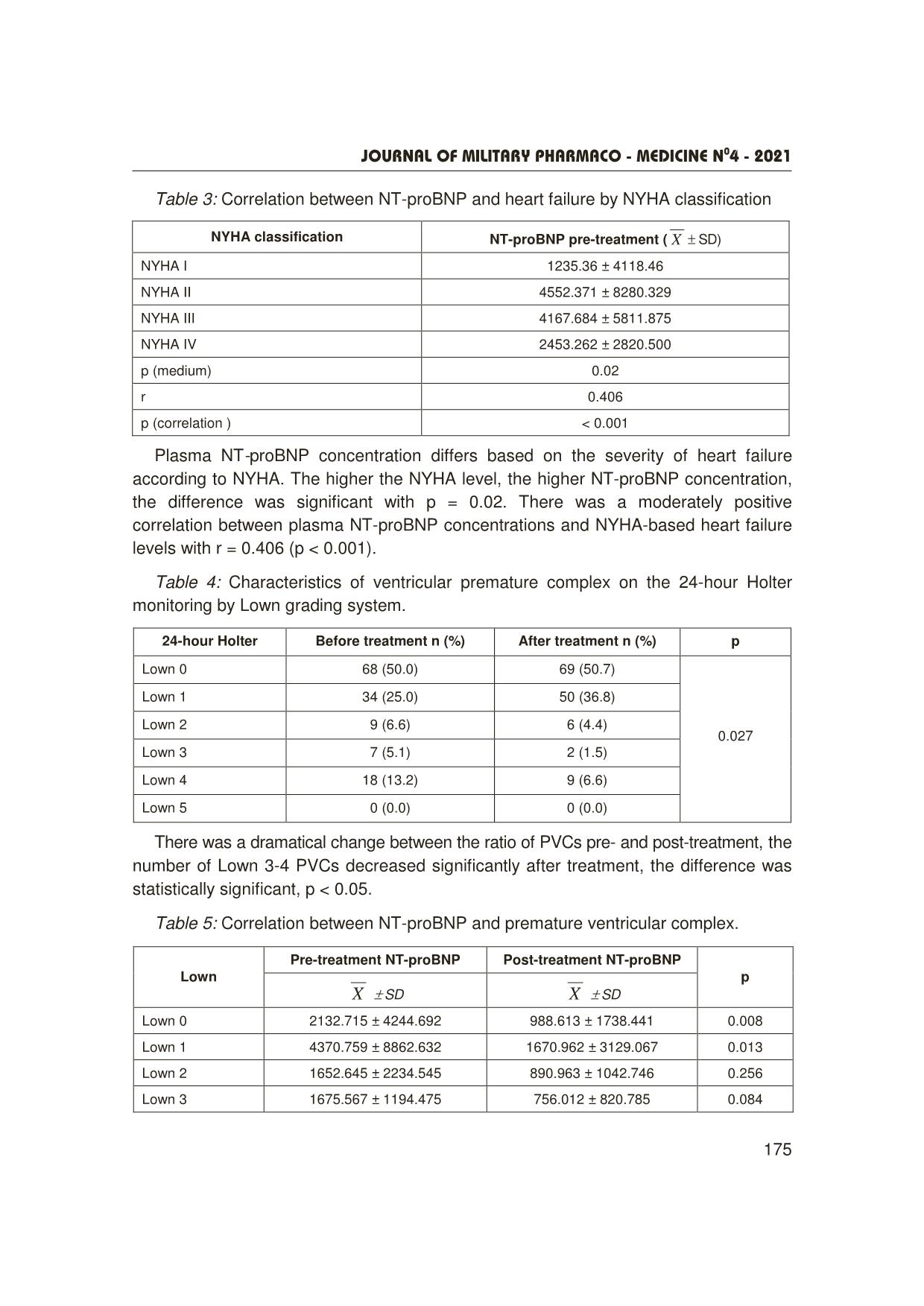
Trang 4
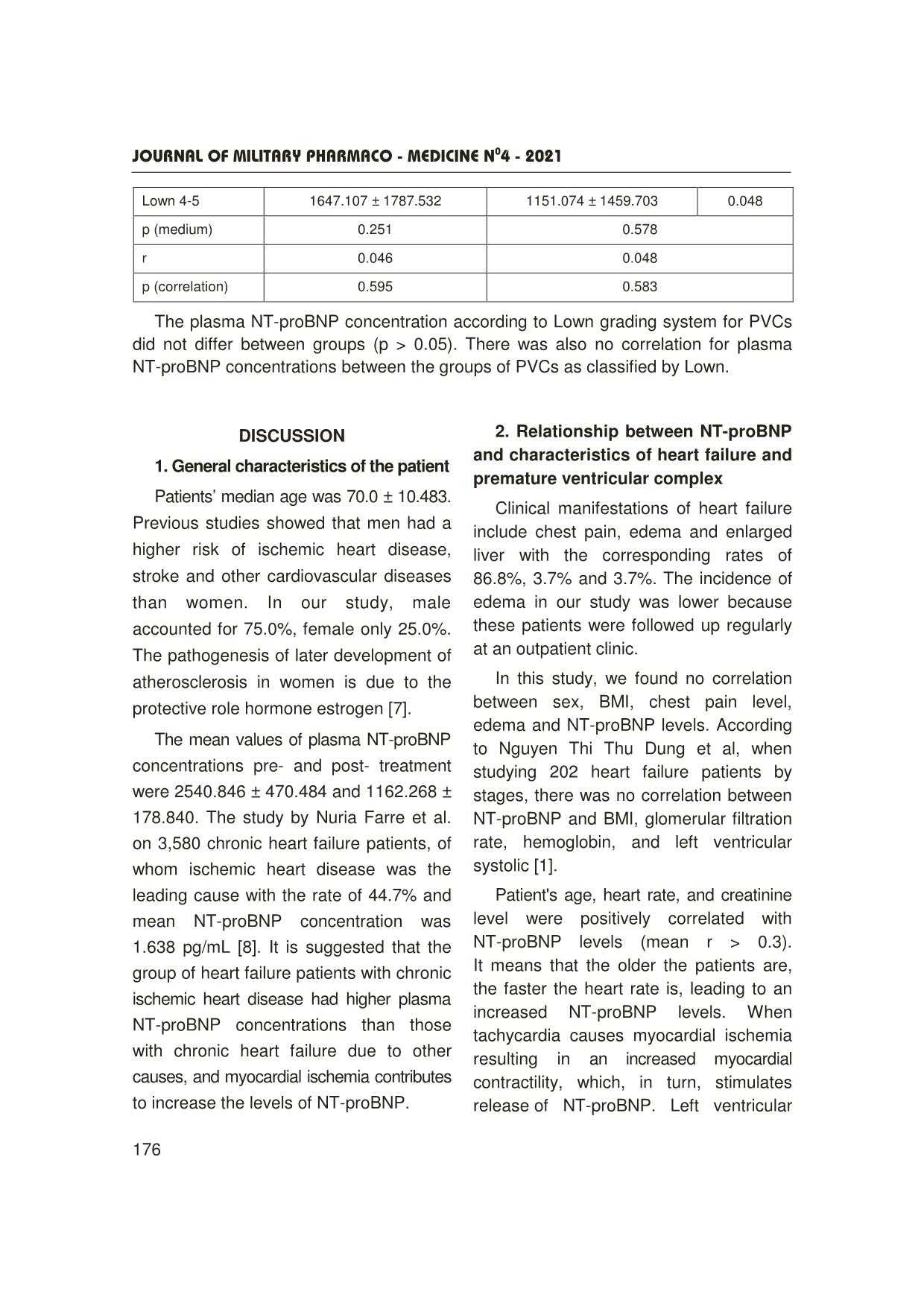
Trang 5
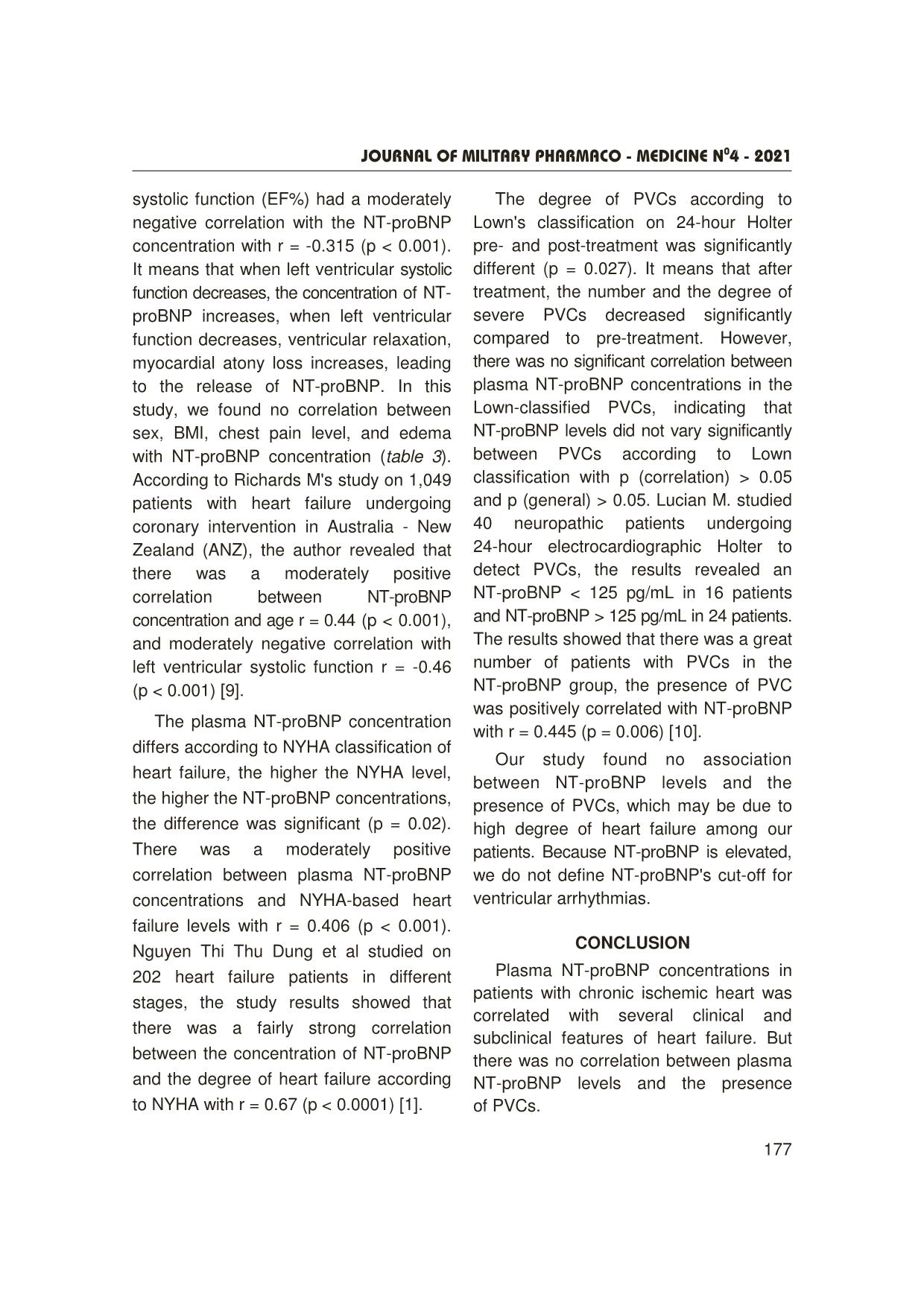
Trang 6
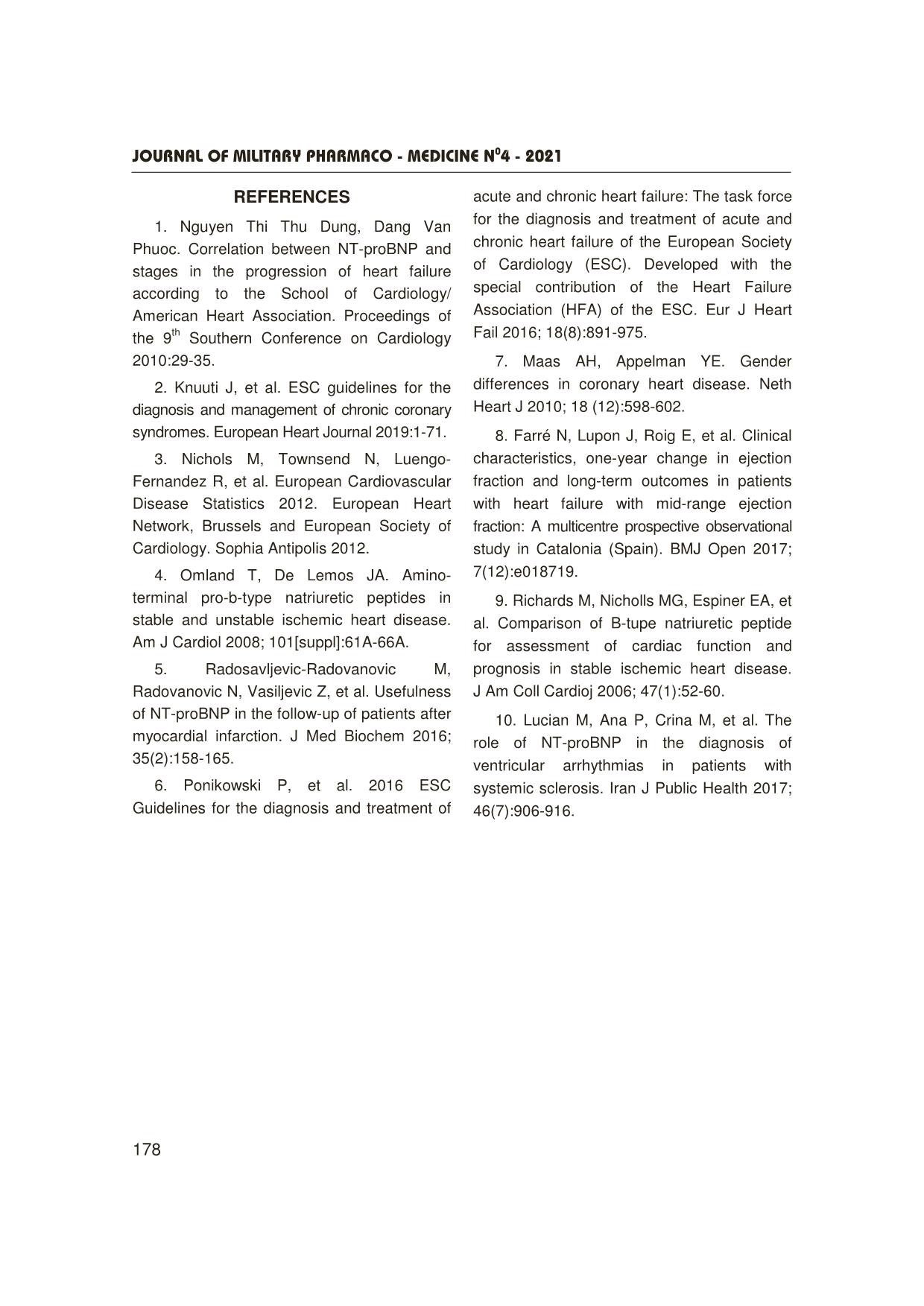
Trang 7
Tóm tắt nội dung tài liệu: Relationship between the plasma nt-Probnp concentration and characteristics of heart failure and premature ventricular complexes in stable ischemic heart disease
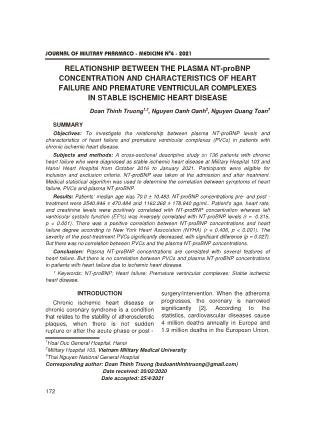
Journal OF MILITARY PHARMACO - MEDICINE N04 - 2021 172 RELATIONSHIP BETWEEN THE PLASMA NT-proBNP CONCENTRATION AND CHARACTERISTICS OF HEART FAILURE AND PREMATURE VENTRICULAR COMPLEXES IN STABLE ISCHEMIC HEART DISEASE Doan Thinh Truong1,2, Nguyen Oanh Oanh2, Nguyen Quang Toan3 SUMMARY Objectives: To investigate the relationship between plasma NT-proBNP levels and characteristics of heart failure and premature ventricular complexes (PVCs) in patients with chronic ischemic heart disease. Subjects and methods: A cross-sectional descriptive study on 136 patients with chronic heart failure who were diagnosed as stable ischemic heart disease at Military Hospital 103 and Hanoi Heart Hospital from October 2016 to January 2021. Participants were eligible for inclusion and exclusion criteria. NT-proBNP was taken at the admission and after treatment. Medical statistical algorithm was used to determine the correlation between symptoms of heart failure, PVCs and plasma NT-proBNP. Results: Patients’ median age was 70.0 ± 10.483. NT-proBNP concentrations pre- and post - treatment were 2540.846 ± 470.484 and 1162.268 ± 178.840 pg/mL. Patient's age, heart rate, and creatinine levels were positively correlated with NT-proBNP concentration whereas left ventricular systolic function (EF%) was inversely correlated with NT-proBNP levels (r = -0.315, p < 0.001). There was a positive correlation between NT-proBNP concentrations and heart failure degree according to New York Heart Association (NYHA) (r = 0.406, p < 0.001). The severity of the post-treatment PVCs significantly decreased, with significant difference (p = 0.027). But there was no correlation between PVCs and the plasma NT-proBNP concentrations. Conclusion: Plasma NT-proBNP concentrations are correlated with several features of heart failure. But there is no correlation between PVCs and plasma NT-proBNP concentrations in patients with heart failure due to ischemic heart disease. * Keywords: NT-proBNP; Heart failure; Premature ventricular complexes; Stable ischemic heart disease. INTRODUCTION Chronic ischemic heart disease or chronic coronary syndrome is a condition that relates to the stability of atherosclerotic plaques, when there is not sudden rupture or after the acute phase or post - surgery/intervention. When the atheroma progresses, the coronary is narrowed significantly [2]. According to the statistics, cardiovascular diseases cause 4 million deaths annually in Europe and 1.9 million deaths in the European Union, 1Hoai Duc General Hospital, Hanoi 2Military Hospital 103, Vietnam Military Medical University 3Thai Nguyen National General Hospital Corresponding author: Doan Thinh Truong (bsdoanthinhtruong@gmail.com) Date received: 20/02/2020 Date accepted: 25/4/2021 Journal OF MILITARY PHARMACO - MEDICINE N04 - 2021 173 mainly due to coronary artery disease (CHD) [3]. Myocadial ischemia in chronic coronary syndrome leads to functional impairment of an area of the left ventricular heart muscle, disorders of left ventricular relaxation, and then increased passive stiffness promotes diastolic filling, hypertrophy and myocardial fibrosis. Cardiac ischemia in cardiovascular disease can trigger electrophysiological changes and arrhythmias. When myocardial ischemia and hypoxia occur, the release of NT-proBNP is stimulated. Other factors in myocardial ischemia include increased heart rate, proinflammatory cytokines and neurotransmitters such as vasoconstriction, antidiuretic, rapidly increasing left ventricular pressure and cell proliferation. Birth also stimulates NT- proBNP synthesis [4]. Studies show that NT-proBNP test plays a pivotal role in screening, diagnosing, and predicting cardiovascular events such as heart failure, arrhythmia, etc. in patients with chronic coronary syndrome [5]. Therefore, we conducted this project with the following objectives: To investigate the relationship between NT-proBNP levels and characteristics of heart failure and PVCs in patients with chronic ischemic heart disease. SUBJECTS AND METHODS 1. Subjects 136 patients with chronic heart failure were diagnosed as ischemic heart disease at Military Hospital 103 and Hanoi Heart Hospital from October 2016 to January 2021 * Selection criteria: Patients with a diagnosis or a history of acute myocardial infarction; Patients with significant coronary lesions (one coronary artery stenosis of at least 50% by coronary angiography at the time of the study or before; Patients undergoing coronary revascularization or without intervention; Patients undergoing coronary bypass surgery; Patients with stable angina or unstable angina. - Patient was diagnosed with heart failure by ESC 2016 [6]. * Exclusion criteria: Patients had chronic kidney disease, severe arrhythmia, pericardial disease, myocarditis, infectious endocarditis, or other severe chronic disease, or those who did not agree to participate in the study. 2. Method A cross-sectional descriptive study. * Sampling method: Convenient sample, including all patients who met the inclusion criteria. * Research target: Age, sex, clinical symptoms (blood pressure, pulse, breathing rate, edema, heart failure degree according to NYHA, degree of chest pain according to CCS, ...), subclinical features (plasma NT-ProBNP, EF, Dd, ...). * Data processing: By SPSS statistical software version 21.0. The statistical significance level is 95% with p < 0.05. Journal OF MILITARY PHARMACO - MEDICINE N04 - 2021 174 RESULTS Through a study on 136 heart failure patients with chronic ischemic heart disease, we obtained the following results: Table 1: General characteristics of study subjects. Characteristics Parameters Females (n, %) 34 (25.0) Age ( X ± SD) 70.0 ± 10.483 Hypertension (n, %) 105 (77.2) Smoke (n, %) 25 (18.4) Chest pain (n, %) 118 (86.8) Edema (n, %) 19 (3.7) Rale in the lungs (n, %) 25 (18.4) Enlarged liver, jugular vein (n, %) 5 (3.7) Diastolic blood pressure (mmHg) ( X ± SD) 88.49 ± 25.212 Systolic blood pressure (mmHg) ( X ± SD) 135.10 ± 25.568 Ejection fraction (%) 54.689 ± 17.839 NT-proBNP before treatment (pg/mL) ( X ± SD) 2540.846 ± 5486.735 NT-proBNP after treatment (pg/mL) ( X ± SD) 1162.268 ± 2085.617 Male/female ratio: 3/1. Hypertension accounted for the highest percentage (77.2%). The mean age was 70.0 ± 10.483. Mean values of NT-proBNP pre- and post-treatment were different. Table 2: Relationship between plasma NT-proBNP concentrations and heart failure characteristics. Before treatment Correlation index r p Age 0.195 0.023 Gender -0.065 0.454 Body mass index (BMI) 0.108 0.209 Edema 0.141 0.102 Chest pain -0.083 0.335 Heart rate 0.302 < 0.001 Creatinine 0.322 < 0.001 Ejection fraction (%) -0.315 < 0.001 Patient's age, heart rate, creatinine level were positively correlated with NT-proBNP concentration, left ventricular systolic function (EF%) was inversely correlated with NT-proBNP concentration. In this study, we found no correlation between gender, BMI, chest pain level, edema and NT-proBNP levels. Journal OF MILITARY PHARMACO - MEDICINE N04 - 2021 175 Table 3: Correlation between NT-proBNP and heart failure by NYHA classification NYHA classification NT-proBNP pre-treatment ( X ± SD) NYHA I 1235.36 ± 4118.46 NYHA II 4552.371 ± 8280.329 NYHA III 4167.684 ± 5811.875 NYHA IV 2453.262 ± 2820.500 p (medium) 0.02 r 0.406 p (correlation ) < 0.001 Plasma NT-proBNP concentration differs based on the severity of heart failure according to NYHA. The higher the NYHA level, the higher NT-proBNP concentration, the difference was significant with p = 0.02. There was a moderately positive correlation between plasma NT-proBNP concentrations and NYHA-based heart failure levels with r = 0.406 (p < 0.001). Table 4: Characteristics of ventricular premature complex on the 24-hour Holter monitoring by Lown grading system. 24-hour Holter Before treatment n (%) After treatment n (%) p Lown 0 68 (50.0) 69 (50.7) Lown 1 34 (25.0) 50 (36.8) Lown 2 9 (6.6) 6 (4.4) Lown 3 7 (5.1) 2 (1.5) Lown 4 18 (13.2) 9 (6.6) Lown 5 0 (0.0) 0 (0.0) 0.027 There was a dramatical change between the ratio of PVCs pre- and post-treatment, the number of Lown 3-4 PVCs decreased significantly after treatment, the difference was statistically significant, p < 0.05. Table 5: Correlation between NT-proBNP and premature ventricular complex. Pre-treatment NT-proBNP Post-treatment NT-proBNP Lown X ± SD X ± SD p Lown 0 2132.715 ± 4244.692 988.613 ± 1738.441 0.008 Lown 1 4370.759 ± 8862.632 1670.962 ± 3129.067 0.013 Lown 2 1652.645 ± 2234.545 890.963 ± 1042.746 0.256 Lown 3 1675.567 ± 1194.475 756.012 ± 820.785 0.084 Journal OF MILITARY PHARMACO - MEDICINE N04 - 2021 176 Lown 4-5 1647.107 ± 1787.532 1151.074 ± 1459.703 0.048 p (medium) 0.251 0.578 r 0.046 0.048 p (correlation) 0.595 0.583 The plasma NT-proBNP concentration according to Lown grading system for PVCs did not differ between groups (p > 0.05). There was also no correlation for plasma NT-proBNP concentrations between the groups of PVCs as classified by Lown. DISCUSSION 1. General characteristics of the patient Patients’ median age was 70.0 ± 10.483. Previous studies showed that men had a higher risk of ischemic heart disease, stroke and other cardiovascular diseases than women. In our study, male accounted for 75.0%, female only 25.0%. The pathogenesis of later development of atherosclerosis in women is due to the protective role hormone estrogen [7]. The mean values of plasma NT-proBNP concentrations pre- and post- treatment were 2540.846 ± 470.484 and 1162.268 ± 178.840. The study by Nuria Farre et al. on 3,580 chronic heart failure patients, of whom ischemic heart disease was the leading cause with the rate of 44.7% and mean NT-proBNP concentration was 1.638 pg/mL [8]. It is suggested that the group of heart failure patients with chronic ischemic heart disease had higher plasma NT-proBNP concentrations than those with chronic heart failure due to other causes, and myocardial ischemia contributes to increase the levels of NT-proBNP. 2. Relationship between NT-proBNP and characteristics of heart failure and premature ventricular complex Clinical manifestations of heart failure include chest pain, edema and enlarged liver with the corresponding rates of 86.8%, 3.7% and 3.7%. The incidence of edema in our study was lower because these patients were followed up regularly at an outpatient clinic. In this study, we found no correlation between sex, BMI, chest pain level, edema and NT-proBNP levels. According to Nguyen Thi Thu Dung et al, when studying 202 heart failure patients by stages, there was no correlation between NT-proBNP and BMI, glomerular filtration rate, hemoglobin, and left ventricular systolic [1]. Patient's age, heart rate, and creatinine level were positively correlated with NT-proBNP levels (mean r > 0.3). It means that the older the patients are, the faster the heart rate is, leading to an increased NT-proBNP levels. When tachycardia causes myocardial ischemia resulting in an increased myocardial contractility, which, in turn, stimulates release of NT-proBNP. Left ventricular Journal OF MILITARY PHARMACO - MEDICINE N04 - 2021 177 systolic function (EF%) had a moderately negative correlation with the NT-proBNP concentration with r = -0.315 (p < 0.001). It means that when left ventricular systolic function decreases, the concentration of NT- proBNP increases, when left ventricular function decreases, ventricular relaxation, myocardial atony loss increases, leading to the release of NT-proBNP. In this study, we found no correlation between sex, BMI, chest pain level, and edema with NT-proBNP concentration (table 3). According to Richards M's study on 1,049 patients with heart failure undergoing coronary intervention in Australia - New Zealand (ANZ), the author revealed that there was a moderately positive correlation between NT-proBNP concentration and age r = 0.44 (p < 0.001), and moderately negative correlation with left ventricular systolic function r = -0.46 (p < 0.001) [9]. The plasma NT-proBNP concentration differs according to NYHA classification of heart failure, the higher the NYHA level, the higher the NT-proBNP concentrations, the difference was significant (p = 0.02). There was a moderately positive correlation between plasma NT-proBNP concentrations and NYHA-based heart failure levels with r = 0.406 (p < 0.001). Nguyen Thi Thu Dung et al studied on 202 heart failure patients in different stages, the study results showed that there was a fairly strong correlation between the concentration of NT-proBNP and the degree of heart failure according to NYHA with r = 0.67 (p < 0.0001) [1]. The degree of PVCs according to Lown's classification on 24-hour Holter pre- and post-treatment was significantly different (p = 0.027). It means that after treatment, the number and the degree of severe PVCs decreased significantly compared to pre-treatment. However, there was no significant correlation between plasma NT-proBNP concentrations in the Lown-classified PVCs, indicating that NT-proBNP levels did not vary significantly between PVCs according to Lown classification with p (correlation) > 0.05 and p (general) > 0.05. Lucian M. studied 40 neuropathic patients undergoing 24-hour electrocardiographic Holter to detect PVCs, the results revealed an NT-proBNP < 125 pg/mL in 16 patients and NT-proBNP > 125 pg/mL in 24 patients. The results showed that there was a great number of patients with PVCs in the NT-proBNP group, the presence of PVC was positively correlated with NT-proBNP with r = 0.445 (p = 0.006) [10]. Our study found no association between NT-proBNP levels and the presence of PVCs, which may be due to high degree of heart failure among our patients. Because NT-proBNP is elevated, we do not define NT-proBNP's cut-off for ventricular arrhythmias. CONCLUSION Plasma NT-proBNP concentrations in patients with chronic ischemic heart was correlated with several clinical and subclinical features of heart failure. But there was no correlation between plasma NT-proBNP levels and the presence of PVCs. Journal OF MILITARY PHARMACO - MEDICINE N04 - 2021 178 REFERENCES 1. Nguyen Thi Thu Dung, Dang Van Phuoc. Correlation between NT-proBNP and stages in the progression of heart failure according to the School of Cardiology/ American Heart Association. Proceedings of the 9th Southern Conference on Cardiology 2010:29-35. 2. Knuuti J, et al. ESC guidelines for the diagnosis and management of chronic coronary syndromes. European Heart Journal 2019:1-71. 3. Nichols M, Townsend N, Luengo- Fernandez R, et al. European Cardiovascular Disease Statistics 2012. European Heart Network, Brussels and European Society of Cardiology. Sophia Antipolis 2012. 4. Omland T, De Lemos JA. Amino- terminal pro-b-type natriuretic peptides in stable and unstable ischemic heart disease. Am J Cardiol 2008; 101[suppl]:61A-66A. 5. Radosavljevic-Radovanovic M, Radovanovic N, Vasiljevic Z, et al. Usefulness of NT-proBNP in the follow-up of patients after myocardial infarction. J Med Biochem 2016; 35(2):158-165. 6. Ponikowski P, et al. 2016 ESC Guidelines for the diagnosis and treatment of acute and chronic heart failure: The task force for the diagnosis and treatment of acute and chronic heart failure of the European Society of Cardiology (ESC). Developed with the special contribution of the Heart Failure Association (HFA) of the ESC. Eur J Heart Fail 2016; 18(8):891-975. 7. Maas AH, Appelman YE. Gender differences in coronary heart disease. Neth Heart J 2010; 18 (12):598-602. 8. Farré N, Lupon J, Roig E, et al. Clinical characteristics, one-year change in ejection fraction and long-term outcomes in patients with heart failure with mid-range ejection fraction: A multicentre prospective observational study in Catalonia (Spain). BMJ Open 2017; 7(12):e018719. 9. Richards M, Nicholls MG, Espiner EA, et al. Comparison of B-tupe natriuretic peptide for assessment of cardiac function and prognosis in stable ischemic heart disease. J Am Coll Cardioj 2006; 47(1):52-60. 10. Lucian M, Ana P, Crina M, et al. The role of NT-proBNP in the diagnosis of ventricular arrhythmias in patients with systemic sclerosis. Iran J Public Health 2017; 46(7):906-916.
File đính kèm:
 relationship_between_the_plasma_nt_probnp_concentration_and.pdf
relationship_between_the_plasma_nt_probnp_concentration_and.pdf

